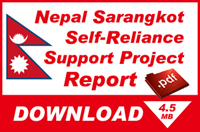We, The Association for Nepal Synapse Self-Reliance Support in Japan,support “the creation of sustainable communities”
The completion of the restaurant is just a beginning.
People could not find a job to earn a living despite their willingness to work. Children could not go to school due to the poverty. – It was in 2008 when we first learned of the distress the people of Sarangkot Village, Nepal, were in. When the landslide caused by the heavy rain in 2007 completely destroyed the community hall which was yet under construction, the villagers lost sight of what steps should be taken next.
We inspected the site and promised to render our full cooperation to reconstruct the new community hall. We established “NPO, The Association for Nepal Synapse Self-Reliance Support in Japan” in November 2008, and started to give full support. Just making monetary contributions to build the hall does not constitute support in a real sense. We started the “Nepal Sarangkot Self-Reliance Support Project” to create a community whose members, can earn their own living and sustain their lives.
Firstly, we contacted the Nepalese NGO “SAGUN*1” and requested research and other cooperation. We built programs through discussion with local citizens’ organizations which engaged in community activities such as “SSMG*2”, the female villagers’ group and other villagers. The new community hall was named Synapse Work Training Center (Training Center, hereafter). It is used not only for meetings, but also for training courses, e.g. occupational training mainly for females. We targeted the development of tourism which can generate cash income, and built the Sarangkot Fordays Restaurant (Restaurant, hereafter).
Our support program deliberately sets the time frame of five years. By building a cyclical economic system in Sarangkot Village within that period, we aim to support the villagers to acquire means to lead stable lives permanently.


To change the lives in the poverty-stricken Sarangkot Village.
Nepal is a country known for its beautiful scenery of Himalaya Mountains. However, the villagers’ face a harsh reality. The industrial foundation is fragile, even that of their main industry of agriculture, and the country is one of the “Least Developed Countries” with the second lowest GNI (Gross National Income) in Asia, only after Afghanistan. 2009 statistics suggested per capita GNI of $440 for this county while Japan earned $37,870 per person.
Sarangkot Village, where many of the tourists who visit Pokhara also visit, was no exception. Different castes and tribes co-existed in the village. The difference in income and living standards could not readily be changed. Only limited jobs were available within the region and many of fathers with insufficient income sources worked abroad, e.g. India. Only women, small children and elderly people lived in the village. School enrollment rate was not high as many parents could not even pay the tuition.
Mothers who stayed in the village were not able to receive good education, thus did not have any means to earn a living. SAGUN’s research and the discussion with the villagers revealed that the first priority should be to give mothers skills so that they can earn cash income themselves. When they can secure steady income, it leads to the improvement of educational environment for children.
To make the mothers’ dream for their beloved children come true, we started our activity with supporting their self-reliance.

